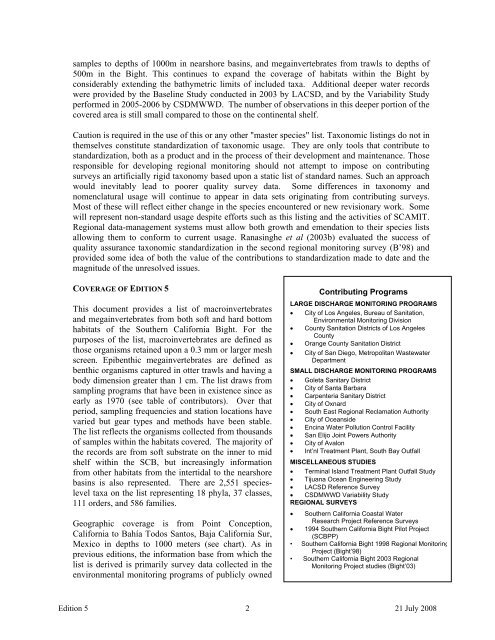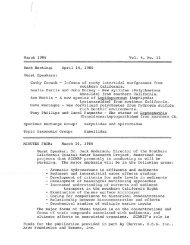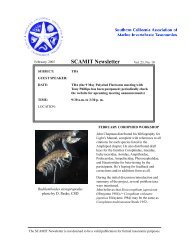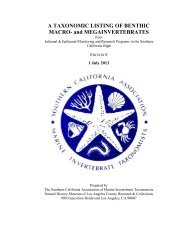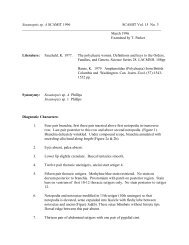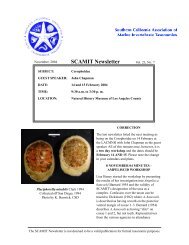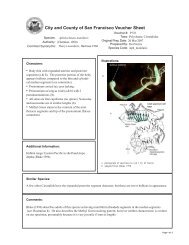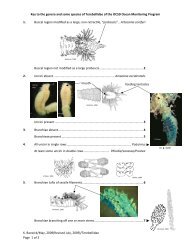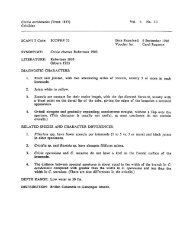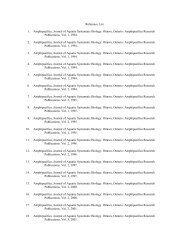Download - scamit
Download - scamit
Download - scamit
You also want an ePaper? Increase the reach of your titles
YUMPU automatically turns print PDFs into web optimized ePapers that Google loves.
samples to depths of 1000m in nearshore basins, and megainvertebrates from trawls to depths of<br />
500m in the Bight. This continues to expand the coverage of habitats within the Bight by<br />
considerably extending the bathymetric limits of included taxa. Additional deeper water records<br />
were provided by the Baseline Study conducted in 2003 by LACSD, and by the Variability Study<br />
performed in 2005-2006 by CSDMWWD. The number of observations in this deeper portion of the<br />
covered area is still small compared to those on the continental shelf.<br />
Caution is required in the use of this or any other "master species" list. Taxonomic listings do not in<br />
themselves constitute standardization of taxonomic usage. They are only tools that contribute to<br />
standardization, both as a product and in the process of their development and maintenance. Those<br />
responsible for developing regional monitoring should not attempt to impose on contributing<br />
surveys an artificially rigid taxonomy based upon a static list of standard names. Such an approach<br />
would inevitably lead to poorer quality survey data. Some differences in taxonomy and<br />
nomenclatural usage will continue to appear in data sets originating from contributing surveys.<br />
Most of these will reflect either change in the species encountered or new revisionary work. Some<br />
will represent non-standard usage despite efforts such as this listing and the activities of SCAMIT.<br />
Regional data-management systems must allow both growth and emendation to their species lists<br />
allowing them to conform to current usage. Ranasinghe et al (2003b) evaluated the success of<br />
quality assurance taxonomic standardization in the second regional monitoring survey (B’98) and<br />
provided some idea of both the value of the contributions to standardization made to date and the<br />
magnitude of the unresolved issues.<br />
COVERAGE OF EDITION 5<br />
This document provides a list of macroinvertebrates<br />
and megainvertebrates from both soft and hard bottom<br />
habitats of the Southern California Bight. For the<br />
purposes of the list, macroinvertebrates are defined as<br />
those organisms retained upon a 0.3 mm or larger mesh<br />
screen. Epibenthic megainvertebrates are defined as<br />
benthic organisms captured in otter trawls and having a<br />
body dimension greater than 1 cm. The list draws from<br />
sampling programs that have been in existence since as<br />
early as 1970 (see table of contributors). Over that<br />
period, sampling frequencies and station locations have<br />
varied but gear types and methods have been stable.<br />
The list reflects the organisms collected from thousands<br />
of samples within the habitats covered. The majority of<br />
the records are from soft substrate on the inner to mid<br />
shelf within the SCB, but increasingly information<br />
from other habitats from the intertidal to the nearshore<br />
basins is also represented. There are 2,551 specieslevel<br />
taxa on the list representing 18 phyla, 37 classes,<br />
111 orders, and 586 families.<br />
Geographic coverage is from Point Conception,<br />
California to Bahía Todos Santos, Baja California Sur,<br />
Mexico in depths to 1000 meters (see chart). As in<br />
previous editions, the information base from which the<br />
list is derived is primarily survey data collected in the<br />
environmental monitoring programs of publicly owned<br />
Contributing Programs<br />
LARGE DISCHARGE MONITORING PROGRAMS<br />
• City of Los Angeles, Bureau of Sanitation,<br />
Environmental Monitoring Division<br />
• County Sanitation Districts of Los Angeles<br />
County<br />
• Orange County Sanitation District<br />
• City of San Diego, Metropolitan Wastewater<br />
Department<br />
SMALL DISCHARGE MONITORING PROGRAMS<br />
• Goleta Sanitary District<br />
• City of Santa Barbara<br />
• Carpenteria Sanitary District<br />
• City of Oxnard<br />
• South East Regional Reclamation Authority<br />
• City of Oceanside<br />
• Encina Water Pollution Control Facility<br />
• San Elijo Joint Powers Authority<br />
• City of Avalon<br />
• Int’nl Treatment Plant, South Bay Outfall<br />
MISCELLANEOUS STUDIES<br />
• Terminal Island Treatment Plant Outfall Study<br />
• Tijuana Ocean Engineering Study<br />
• LACSD Reference Survey<br />
• CSDMWWD Variability Study<br />
REGIONAL SURVEYS<br />
• Southern California Coastal Water<br />
Research Project Reference Surveys<br />
• 1994 Southern California Bight Pilot Project<br />
(SCBPP)<br />
• Southern California Bight 1998 Regional Monitoring<br />
Project (Bight’98)<br />
• Southern California Bight 2003 Regional<br />
Monitoring Project studies (Bight’03)<br />
Edition 5 2 21 July 2008


